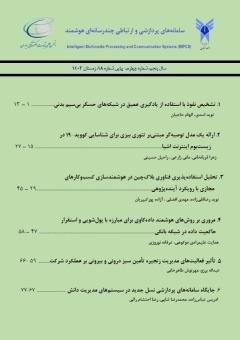بهبود ویژگیهای آنتن میکرواستریپ با خط تغذیه هممحور با استفاده از فوق لایه فرامواد
محورهای موضوعی : پردازش چند رسانه ای، سیستمهای ارتباطی، سیستمهای هوشمند
رضا خواجه محمدلو
1
*
![]() ,
مهدی جلالی
2
,
مهدی جلالی
2
![]()
1 - استادیار، گروه برق، واحد میاندوآب، دانشگاه آزاد اسلامی، میاندوآب، ایران.
2 - استادیار، گروه برق، واحد نقده، دانشگاه آزاد اسلامی، نقده، ایران
کلید واژه: آنتن میکرواستریپ, فوق لایه فرامواد, پدیده فوقشکست, سمتگرایی, بهره,
چکیده مقاله :
در این مقاله یک آنتن میکرواستریپ با سمتگرایی بالا که شامل یک و دو فوقلایه فرامواد برای کاربردهای باند Ku در سیستم های مخابراتی سیار مورد تحقیق قرار گرفته است. ساختارهای فرامواد، ساختارهای متناوب هستند که در دهههای اخیر به علت ویژگیهای متمایز مانند پدیده فوق شکست و نفوذ پذیری نسبی الکتریکی و مغناطیسی منفی، توسط محققان بسیاری مورد مطالعه و تحقیق قرار گرفتهاند. آنتنهای میکرواستریپ به خاطر داشتن ویژگی خصوصیات بارزی مانند هزینه ساخت مناسب و وزن کم در سیستمهای بیسیم بسیار مورد استفاده قرار می گیرد. یکی از معایب این آنتنها بهره نامناسب آن است. یک آنتن پچ میکرواستریپ به عنوان منبع تشعشع استفاده شده است و نرم افزار Ansoft HFSS برای شبیهسازی استفاده شده است. نتایج نشان میدهد که بهره، سمت گرایی و پهنای باند آنتن با فوق لایه فرامواد در باند فرکانسی (Ku) 12-18 گیگاهرتز افزایش یافته است. در مقایسه با آنتن پچ متعارف با اندازه پنجره تشعشعی مشابه اما بدون فوقلایه فرامواد، کارآیی و عملکرد آنتن میکرواستریپ به طور آشکاری بهبود یافته است.
Abstract
Introduction: In this article, a microstrip antenna with high directivity, which includes one and two metamaterial super-layers, has been investigated. Metamaterial structures are alternating structures studied and researched by many researchers in recent decades due to their distinctive features such as super fracture phenomenon and negative relative electric and magnetic permeability. A patch antenna is used as a radiation source and Ansoft HFSS software is used for simulation. The results show that the gain, directivity, and bandwidth of the antenna with the metamaterial super-layer have increased in the frequency band (Ku) of 12-18 GHz. Compared with the conventional patch antenna with the same size of the radiation windows but without the metamaterial super layer, the efficiency of the microstrip antenna is improved.
Method: Parametric examination of the antenna is one of the main parts of the antenna design because it determines some characteristics of the antenna and optimal values. HFSS software is used to extract simulation results. In this section, the return loss, gain, and directivity of the antenna with metamaterial super layers, with different design parameters, have been studied.
Results: In short, in this article, a type of antenna with high gain and directivity using a metamaterial super-layer is presented. The simulation results show that the refractive index of the metamaterial super-layer is close to zero in a wide frequency band around 4 GHz, and the gain of the antenna has increased from 5.8 to 10.5 GHz in the Ku band. The maximum gain at the frequency of 15.23 GHz is about 12.5 dB using two layers of metamaterials.
Discussion: From the return loss curve, it can be seen that the bandwidth (S11≤10dB) with a metamaterial super-layer is in the range of 13.5 to 18 GHz for a distance of Ld1=10.8 mm from the metamaterial super-layer of the microstrip antenna patch, which is compared to the original strip antenna. Without the metamaterial super-layer, the bandwidth is increased to about 2 GHz. It is clear from the curve that the impedance bandwidth of the antenna is not significantly improved compared to the antenna with a super layer, except that the return loss has lower values than the previous structure. It is clear from the curve that the gain of the antenna with the use of a metamaterial super layer is significantly increased compared to the antenna without a super layer. The gain of the antenna with one metamaterial layer has increased by about 2 to 6 dB and for the antenna with two metamaterial layers by about 4 to 8 dB compared to the antenna without the metamaterial super layer. It is clear from the directionality pattern curve that with the presence of the metamaterial super layer the material of the antenna has been improved and its half-power beam width has been reduced. From the results shown, it is clear that the first metamaterial super layer has an effective role in improving the bandwidth, while the second super layer has a significant effect on the gain and directivity of the antenna.

